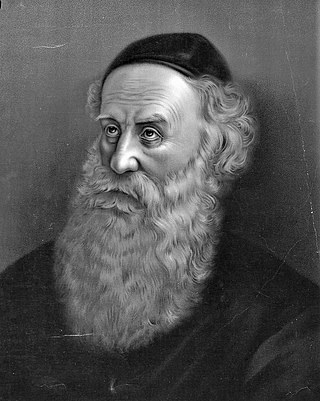
Lust is a psychological force producing intense desire for something, or circumstance while already having a significant amount of the desired object. Lust can take any form such as the lust for sexuality, money, or power. It can take such mundane forms as the lust for food as distinct from the need for food or lust for redolence, when one is lusting for a particular smell that brings back memories. It is similar to but distinguished from passion, in that passion propels individuals to achieve benevolent goals whilst lust does not.

Rabbinic literature, in its broadest sense, is the entire spectrum of rabbinic writings throughout Jewish history. However, the term often refers specifically to literature from the Talmudic era, as opposed to medieval and modern rabbinic writing, and thus corresponds with the Hebrew term Sifrut Chazal. This more specific sense of "Rabbinic literature"—referring to the Talmudim, Midrash, and related writings, but hardly ever to later texts—is how the term is generally intended when used in contemporary academic writing. The terms mefareshim and parshanim (commentaries/commentators) almost always refer to later, post-Talmudic writers of rabbinic glosses on Biblical and Talmudic texts.

Torah study is the study of the Torah, Hebrew Bible, Talmud, responsa, rabbinic literature, and similar works, all of which are Judaism's religious texts. According to Rabbinic Judaism, the study is done for the purpose of the mitzvah ("commandment") of Torah study itself.

Tefillin, or phylacteries, are a set of small black leather boxes with leather straps containing scrolls of parchment inscribed with verses from the Torah. Tefillin are worn by adult Jews during weekday and Sunday morning prayers. In Orthodox and traditional communities, they are worn solely by men, while some Reform and Conservative (Masorti) communities allow them to be worn by any gender. In Jewish Law (halacha), women are exempt from most time-dependent positive commandments, which include tefillin.

Shneur Zalman of Liadi was a rabbi and the founder and first Rebbe of Chabad, a branch of Hasidic Judaism, then based in Liadi in the Grand Duchy of Lithuania and later in the Grodno Governorate of the Russian Empire. He wrote many works, and is best known for Shulchan Aruch HaRav, Tanya, and his Siddur Torah Or compiled according to the Nusach Ari.

In Judaism and Christianity, the tree of the knowledge of good and evil is one of two specific trees in the story of the Garden of Eden in Genesis 2–3, along with the tree of life. Alternatively, some scholars have argued that the tree of the knowledge of good and evil is just another name for the tree of life.

The Tanya is an early work of Hasidic philosophy, by Rabbi Shneur Zalman of Liadi, the founder of Chabad Hasidism, first published in 1796. Its formal title is Likkutei Amarim, but is more commonly known by its first Hebrew word tanya, which means "it has been taught", where he refers to a baraita section in "Niddah", at the end of chapter 3, 30b. Tanya is composed of five sections that define Hasidic mystical psychology and theology as a handbook for daily spiritual life in Jewish observance.

Breslov is a branch of Hasidic Judaism founded by Rebbe Nachman of Breslov (1772–1810), a great-grandson of the Baal Shem Tov, founder of Hasidism. Its adherents strive to develop an intense, joyous relationship with God, and receive guidance toward this goal from the teachings of Rebbe Nachman.

Tzadik is a title in Judaism given to people considered righteous, such as biblical figures and later spiritual masters. The root of the word ṣadiq, is ṣ-d-q, which means "justice" or "righteousness". When applied to a righteous woman, the term is inflected as tzadika/tzaddikot.

Tzitzit are specially knotted ritual fringes, or tassels, worn in antiquity by Israelites and today by observant Jews and Samaritans. Tzitzit are usually attached to the four corners of the tallit gadol, usually referred to simply as a tallit or tallis; and tallit katan. Through synecdoche, a tallit katan may be referred to as tzitzit.
Devekut, debekuth, deveikuth or deveikus is a Jewish concept referring to closeness to God. It may refer to a deep, trance-like meditative state attained during Jewish prayer, Torah study, or when performing the 613 commandments. It is particularly associated with the Jewish mystical tradition.
Talmid Chakham is an honorific title which is given to a man who is well versed in Jewish law, i.e., a Torah scholar. Originally Hebrew: תלמיד חכמים Talmid Chakhamim, lit., "student of sages", pl. תלמידי חכמים talmidei chakhamim, "students of sages"; inaccurate reconstruction of the singular, which is invariably shortened to ת"ח in printings, led to modern Hebrew: תלמיד חכם talmid chakham "sage student". The feminine equivalent is Talmidat Chakhamim, "student of sages", or, by extension of the same error, Talmidah Chakhamah, "sage student".

The gift of the foreleg, cheeks and maw of a kosher-slaughtered animal to a kohen is a positive commandment in the Hebrew Bible. The Shulchan Aruch rules that after the slaughter of animal by a shochet, the shochet is required to separate the cuts of the foreleg, cheek and maw and give them to a kohen freely, without the kohen paying or performing any service.
The following outline is provided as an overview of and topical guide to Judaism:

Kochos/Kochot haNefesh, meaning "Powers of the Soul", are the innate constituent character-aspects within the soul, in Hasidic thought's psychological internalisation of Kabbalah. They derive from the 10 Sephirot Heavenly emanations of Kabbalah, by relating each quality to its parallel internal motivation in man. The Hasidic discussion of the sephirot, particularly in the Kabbalistically oriented system of Habad thought, focuses principally on the Soul Powers, the experience of the sephirot in Jewish worship.
In kabbalah, the divine soul is the source of good inclination, or yetzer tov, and Godly desires.
Within the guidelines of halacha as presented by chazal and early rabbinic authorities, Oral-vulvar stimulation in Halacha is the discussion of whether or not a man may orally stimulate his wife's vulva (cunnilingus) independent of whether this stimulation does or does not result in her achieving orgasm.

Happiness in Judaism and Jewish thought is considered an important value, especially in the context of the service of God. A number of Jewish teachings stress the importance of joy, and demonstrate methods of attaining happiness.

Anger in Judaism is treated as a negative trait to be avoided whenever possible. The subject of anger is treated in a range of Jewish sources, from the Hebrew Bible and Talmud to the rabbinical law, Kabbalah, Hasidism, and contemporary Jewish sources.











